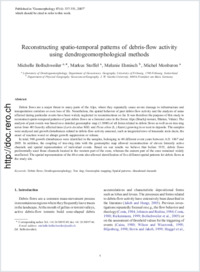Reconstructing spatio-temporal patterns of debris-flow activity using dendrogeomorphological methods
- Bollschweiler, Michelle Laboratory of Dendrogeomorphology, Department of Geosciences, University of Fribourg, Switzerland
- Stoffel, Markus Laboratory of Dendrogeomorphology, Department of Geosciences, University of Fribourg, Switzerland
- Ehmisch, Melanie Department of Physical Geography, Geosciences/Geography, J. W. Goethe-University, Frankfurt am Main, Germany -
- Monbaron, Michel Laboratory of Dendrogeomorphology, Department of Geosciences, University of Fribourg, Switzerland
-
21.11.2006
Published in:
- Geomorphology. - 2007, vol. 87, no. 4, p. 337-351
English
Debris flows are a major threat in many parts of the Alps, where they repeatedly cause severe damage to infrastructure and transportation corridors or even loss of life. Nonetheless, the spatial behavior of past debris-flow activity and the analysis of areas affected during particular events have been widely neglected in reconstructions so far. It was therefore the purpose of this study to reconstruct spatio-temporal patterns of past debris flows on a forested cone in the Swiss Alps (Bruchji torrent, Blatten, Valais). The analysis of past events was based on a detailed geomorphic map (1:1000) of all forms related to debris flows as well as on tree-ring series from 401 heavily affected trees (Larix decidua Mill. and Picea abies (L.) Karst.) growing in or next to deposits. The samples were analyzed and growth disturbances related to debris-flow activity assessed, such as tangential rows of traumatic resin ducts, the onset of reaction wood or abrupt growth suppression or release.In total, 960 growth disturbances were identified in the samples, belonging to 40 different event years between A.D. 1867 and 2005. In addition, the coupling of tree-ring data with the geomorphic map allowed reconstruction of eleven formerly active channels and spatial representation of individual events. Based on our results we believe that before 1935, debris flows preferentially used those channels located in the western part of the cone, whereas the eastern part of the cone remained widely unaffected. The spatial representation of the 40 events also allowed identification of five different spatial patterns for debris flows at the study site.
- Faculty
- Faculté des sciences et de médecine
- Department
- Département de Géosciences
- Language
-
- English
- Classification
- Geography
- License
-
License undefined
- Identifiers
-
- RERO DOC 8419
- DOI 10.1016/j.geomorph.2006.10.002
- Persistent URL
- https://folia.unifr.ch/unifr/documents/300542
Statistics
Document views: 258
File downloads:
- pdf: 377
